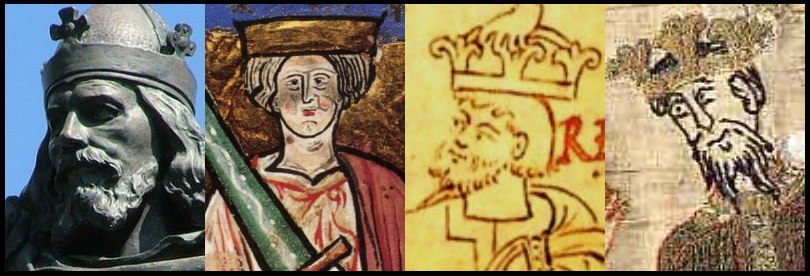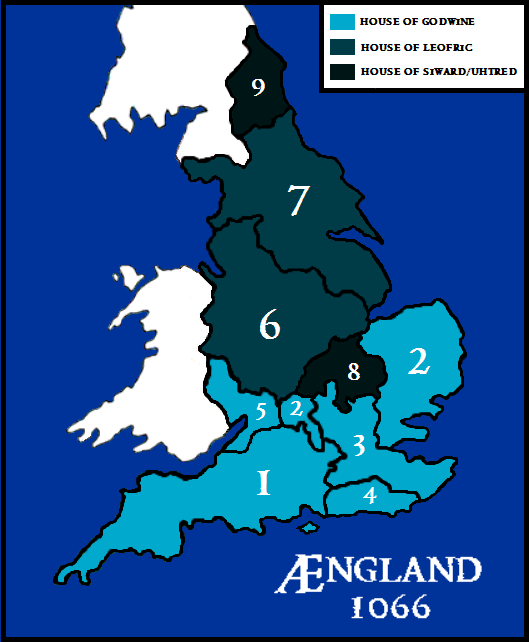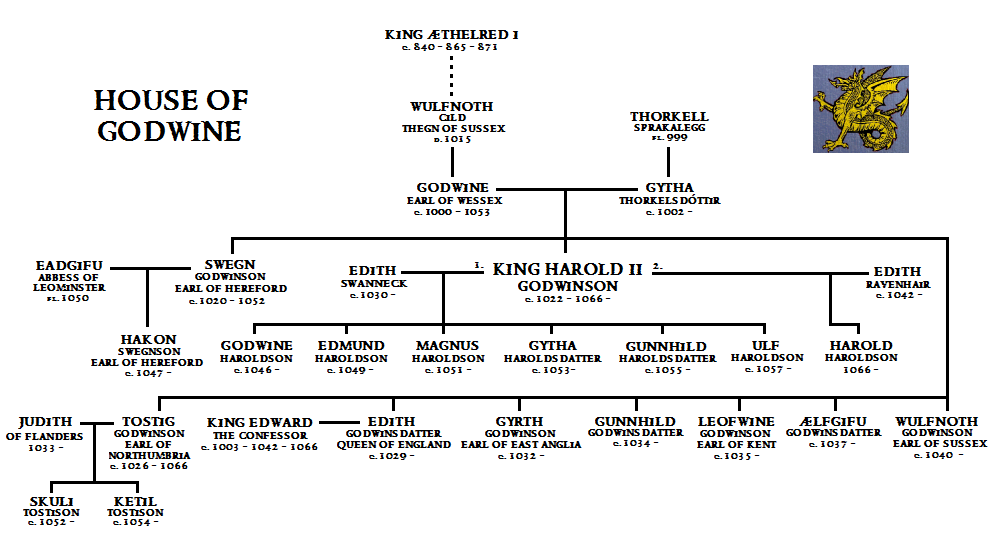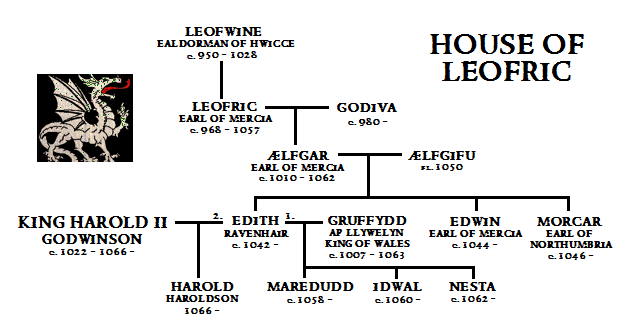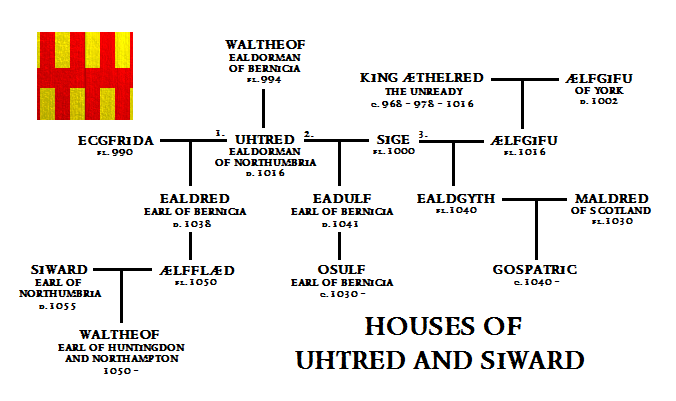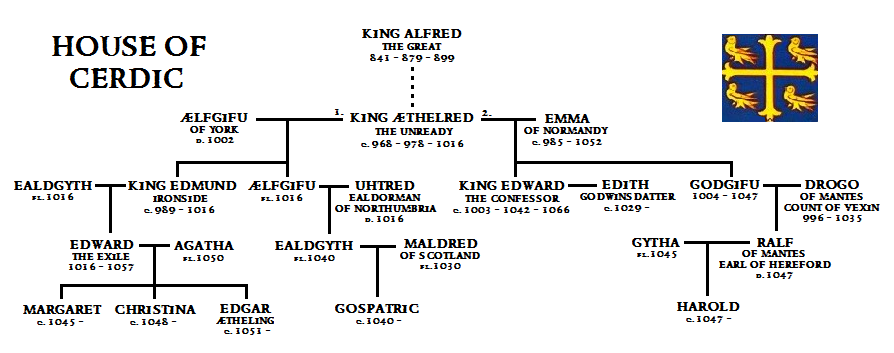Interim: ÆNGLAND AT YEAR’S END, 1066
PART I: A BRIEF HISTORY OF THE KINGDOM OF ÆNGLAND
In the year 1066, Ængland is still a relatively young nation, albeit one built on very ancient foundations.
When the Angles, Saxons and Jutes first settled the island of Britain in the 5th century, their warlords established numerous petty kingdoms, which were ultimately assimilated into seven larger realms known collectively as the Heptarchy. In later centuries however, the efforts of some of the stronger kings to consolidate their power reduced the Heptarchy to four major kingdoms: Westseaxe, Mierce, Northhymbraland and Eastængla. Each of these four regions fought continuously for dominance over the others, leading to a long period of rivalry and bloodshed.
Then in the 9th century the dreaded Vikings came, and only one man was able to resist them: Alfred the Great, King of Westseaxe. Through the efforts of Alfred and his heirs, Westseaxe was able not only to survive the Viking onslaught, but to actually grow stronger, eventually expelling the Vikings and retaking the whole country. All the Anglo-Saxon realms were now united under a single king for the first time in history.
King Alfred’s descendants were supported by dozens of prominent nobles called
ealdormen, each of whom governed a single shire. These great men formed a great council called the
Witenagemot, which was responsible for electing new kings when the old ones died. United under a strong dynasty and empowered by local nobles, the new Kingdom of Ængland began to prosper as a beacon of wealth and learning. However, Ænglish ascendancy was threatened in the late 10th Century by the notoriously poor leadership of King Æthelred II, also known as the Unready, whose reign ended in utter disaster: an invasion by the Danes.
Kings of the Past: (from left to right) Alfred the Great, Æthelred the Unready, Cnut the Dane, and Edward the Confessor.
Having seized Ængland from Æthelred in 1016, the Danish King Cnut ruled as a surprisingly strong and capable ruler. To rule more efficiently, Cnut divided the kingdom between a handful of powerful earls, each ruling an area equivalent to one of the old petty kingdoms. Nevertheless, despite Cnut’s great success, the reigns of his sons were brutish and cruel, and they destabilized the realm as they fought over the crown. When Cnut’s youngest son died in 1042, King Æthelred’s son Edward was able to return to Ængland and restore the rule of the House of Westseaxe.
After living in exile for so many years in Normandy, Edward the Confessor was not a particularly strong king. He imported many Norman and French favorites, and relied heavily on the earls empowered by Cnut to run the country. The greatest of these earls was Godwine of Westseaxe, who struggled through the tempestuous political climate to become the power behind the throne, even going so far as to have his daughter marry the aging king. Later, Harold Godwinson succeeded to his father’s position and became indispensable to King Edward, virtually ruling the entire kingdom on his behalf.
Then Ængland faced crisis yet again when Edward the Confessor died childless in 1066. A succession dispute was born, as several foreign princes claimed the right to inherit Edward’s kingdom. In response to these foreign threats, the Witan elected Harold Godwinson to be their king. Wise and strong, Harold managed to defeat the invasions of his rivals and secure the kingdom once again.
Having now emerged triumphant from the peril of numerous foreign invasions, 11th century Ængland is a peculiar fusion of native Saxon culture and imported Scandinavian and Norman elements. Yet whether the kingdom will continue to prosper under the new rule of the House of Godwine, despite what trials the future may bring, remains unknown. Let no man forget: fate is inexorable.
King Harold II and his Queens, Edith Swanneck (left) and Edith Ravenhair (right).
PART II: THE NOBLE HOUSES
The Earldoms in 1066.
This map illustrates Ængland’s division among the three major houses into nine earldoms.
Key:
1 – Westseaxe, held by King Harold
2 – Eastængla and Oxnaford, held by Earl Gyrth
3 – Cantware and the East Midlands, held by Earl Leofwine
4 – Suthseaxe, held by Earl Wulfnoth
5 – Hereford, held by Earl Hakon
6 – Mierce, held by Earl Edwin
7 – Northhymbraland, held by Earl Morcar
8 – Northhamtun and Huntadun, held by Earl Waltheof
9 – Beornice, held by Earl Osulf
Since the Anglo-Saxons first arrived, Ængland has always had many prominent noble families. At first, these noble houses were independent from each other, each ruling its own scrap of land. The more successful of these would eventually coalesce into the first Saxon royal families. Though the Vikings deposed a great many of these early kings, many of their descendants were kept on as
ealdormen after the royal House of Westseaxe united all Ængland under their rule. However, when Cnut the Dane conquered Ængland, he purged the nobility of potential rivals and traitors, choosing instead to divide the kingdom into four powerful earldoms, roughly equivalent to the four old Anglo-Saxon sub-kingdoms. Each of these was ruled by an earl from a different noble house, with Westseaxe going to the aspiring young Godwine, Mierce to the crafty Leofric, and Northhymbraland and Eastængla going to two of Cnut’s loyal
jarls. When the two
jarls died, Northhymbraland went to the formidable Siward, and Eastængla was passed around between members of whichever of the other three houses was most in favor at the time. Political power is still centered in these major families even now, in 1066.
Named for the eponymous
Godwine, Earl of Westseaxe (d. 1053), few houses have had a more meteoric rise than that which the House of Godwine has experienced in just a few short decades. Though they may have only recently come to power, the Godwines claim a noble heritage nonetheless. Earl Godwine was purportedly descended from King Æthelred I, elder brother to King Alfred, which gives the family a very strong claim to their power-base in Westseaxe. Godwine himself was a major supporter of Edmund Ironside in the war against the Danes, and must have been surprised when his erstwhile enemy Cnut rewarded his loyalty with an earldom. Godwine’s relationship with Edward the Confessor was not as amiable as the one he had enjoyed with Cnut, due to accusations leveled at the Earl concerning the murder of King Edward’s brother. This led to frequent disputes and, on one occasion, the whole Godwine clan was actually placed under a royal ban and exiled from the country! Nothing could deter Earl Godwine though, and the family returned with a vengeance, coercing the king into giving them even more lands than before. Now they hold the crown itself.
Active Members:
•
Harold Godwinson: King of Ængland, formerly Earl of Westseaxe. Performed admirably as Earl of Eastængla in his youth. Succeeded his father Godwine as the strongest and most influential nobleman in the realm in 1053. Served as King Edward the Confessor’s right-hand man for many years, effectively running the kingdom during Edward’s long dotage. Defeated and deposed the Welsh King, Gruffydd ap Llywelyn in 1063, bringing northern Wales under Ænglish suzerainty as a vassal state. Married to two prominent noblewomen: Edith Swanneck and Edith Ravenhair. Elected as king by the Witan upon the Confessor’s death in 1066, in order to defend the realm against multiple threats of foreign invasion. Defeated both Harald Hardrada of Norway and William the Bastard of Normandy within a three week period. Currently enjoys the support of almost all of Ængland’s powerful earls through either kinship or marriage. Has earned considerable prestige at home and abroad for his many victories and magnanimous reputation.
•
Edith Godwinsdatter: Dowager Queen of Ængland. Widow of King Edward the Confessor and younger sister of King Harold. Bitter about being used as a political tool by her father and married to an old man. Harbors a grudge against Harold for the death of her favorite brother Tostig, who was recently slain in rebellion at Stængfordesbrycg. Resides at Wintanceaster, where she persists in her role as châtelaine of the royal treasury and guardian of King Edward’s remaining family heirs. Not to be confused with either of Harold’s wives, who are both also named Edith.
•
Gyrth Godwinson: Earl of Eastængla. Younger brother of King Harold. Appointed as Earl of Eastængla sometime after 1055, further solidifying the House of Godwine’s hold on Ængland. Considered an able leader of men, if somewhat taciturn. Fiercely loyal to his brothers, for whom he would lay down his life if necessary. Renowned as a tough warrior, at times he can be courageous to a fault.
•
Leofwine Godwinson: Earl of Cantware. Younger brother of King Harold. Granted a hodgepodge earldom of several smaller shires to strengthen the Godwine family position. Many consider him to be almost excessively jocular, but nonetheless a skilled and loyal man.
•
Wulfnoth Godwinson: Earl of Suthseaxe. Youngest brother of King Harold. Given as a hostage to King Edward in 1051 as an assurance of his father’s good behavior. Kidnapped by a Norman archbishop fleeing Edward’s displeasure, and given over to Duke William of Normandy for use as a political pawn against the House of Godwine. Released after William’s death by Duchess Matilda to show King Harold her sincerity. Newly appointed as High-reeve (or lesser Earl) of Suthseaxe, specifically to defend the southern coast from any further invasion. Rather skittish after so many years in captivity.
•
Hakon Swegnson: Earl of Hereford. Bastard son of Harold’s infamous eldest brother Swegn, following the latter’s rape of the Abbess of Leominster. Given as a hostage to King Edward and later abducted to Normandy along with his uncle Wulfnoth. Rescued from captivity in 1064 by his uncle Harold, whom he idolizes. Recently appointed to succeed to his late father’s position of Earl of Hereford.
•
Godwine Haroldson: Eldest son of King Harold and Edith Swanneck. Considered to be the most prominent
Ætheling in the kingdom. Brave, jovial, friendly and clever, he possesses his father’s confidence but not his temperance. If his star continues to rise, many expect him to succeed his father in the kingship.
•
Edmund Haroldson: Second son of King Harold and Edith Swanneck. Feels inadequate compared to his father and brother, though some fear he has inherited his uncle Tostig’s dour disposition. Dislikes hunting and battles, preferring books and poetry. Expected by some to pursue a career in the clergy.
•
Magnus Haroldson: Third son of King Harold and Edith Swanneck. Excitable, impetuous and athletic. Loves hunting and falconry to the exclusion of all other pursuits. Essentially the opposite of his brother Edmund, whom he is always trying to liven up.
The House of Leofric is the family of
Leofric, Earl of Mierce (d. 1057). Their immediate ancestors were
ealdormen in Hwicce, but the House of Leofric also claims distant descent from the old royal family of Mierce. When Cnut conquered Ængland in 1016, Leofric was one of very few of the great old Anglo-Saxon nobles to survive his purges. A shrewd politician, Leofric was surpassed in his scheming only by his rival, Godwine of Westseaxe. Leofric is also remembered as the husband of the famous Lady Godiva. The old earl’s considerable accomplishments were nearly lost by his son, the irascible and foolhardy Earl Ælfgar, who made an alliance with the hated Welsh, got himself exiled, and ravaged Hereford in 1055. However, since Ælfgar’s death in 1062, Ængland’s political climate has changed again, with the formerly competing Houses of Godwine and Leofric now united by a marriage alliance and sharing the realm between them.
Active Members:
•
Edith Ravenhair: Queen of Ængland, formerly Queen of Wales. Daughter of Earl Ælfgar. Married when still quite young to King Gruffydd of Wales, whom she disliked immensely, considering him a coward. Abandoned when her husband fled from Harold Godwinson’s successful invasion of Wales. Widowed when Gruffydd was killed by his own men. Married Harold soon thereafter. Has three children from her first husband, also recently gave birth to a son of Harold. Known to possess a sharp wit and a fiery temperament. Not to be confused with Edith Swanneck, Harold's other wife.
•
Edwin Ælfgarson: Earl of Mierce. Elder son of Earl Ælfgar. Succeeded his father as Earl in 1062. Something of a schemer, though he lacks both his grandfather’s cunning and his father’s treachery. Soundly defeated in 1066 by Harald Hardrada at the Battle of Fulfordgeat, narrowly escaped with his life. Now allied to King Harold as his brother-in-law.
•
Morcar Ælfgarson: Earl of Northhymbraland. Younger son of Earl Ælfgar. Chosen by the Northumbrians to be their earl after their rebellion against the oppression of Tostig in 1065. More willful than his brother but somewhat less clever. Also a better fighter than Edwin, but defeated alongside him at Fulfordgeat notwithstanding his skill. Also brother-in-law to King Harold.
THE HOUSES OF UHTRED AND SIWARD
Before they ever came to govern Northhymbraland, the family later known as the the House of Uhtred served as High-reeves of Beornice, the land their ancestors once ruled as kings in days of yore. After the unification of Ængland by the Cerdingas, the House of Uhtred served as
ealdormen in the northernmost shires.
Uhtred (d. 1016), their most prominent scion, was actually the last Ealdorman of Northhymbraland prior to his murder by order of Cnut. When the Danish Earl
Siward (d. 1055) was appointed by Cnut to take over the rule of Northhymbraland, he married one of Uhtred’s daughters to better secure his position. Siward was a bold, independent earl--growing his power and lands over the years and even intervening in the politics of neighboring Scotland on occasion. His death caused a large political power shift, with Northhymbraland going first to the House of Godwine and then the House of Leofric. Now the once great House of Uhtred is divided between old Saxon claimants and the heirs of Siward.
Active Members:
•
Osulf of Bebbanburh: Earl of Beornice. Last surviving heir of Uhtred in the male line. Appointed by Morcar to be High-reeve of his old family lands in Beornice as a conciliatory gesture, after the former became Earl of Northhymbraland. Hates the descendants of Siward as blood-traitors.
•
Waltheof Siwardson: Earl of Huntadun and Northhamtun. The exuberant teenage son of Earl Siward, also his last surviving male heir. Being too young to succeed his father in Northhymbraland, King Edward granted the boy a small earldom of his own in token of his father’s long and illustrious career. Generous and friendly, he seems unaware of his elder cousin Osulf’s ardent rivalry.
•
Gospatric of Lothene: One of very few surviving heirs of Uhtred. Also kin to the King of Scotland through his father’s line and a descendant of Æthelred the Unready through his maternal grandmother. Recently exiled from Ængland as one of the chief lieutenants of the infamous Earl Tostig. He is being watched carefully from afar.
The House of Cerdic has a truly ancient heritage, claiming descent from the legendary
Cerdic (d. 534), the first King of the early West Saxon tribe known as the Gewisse to settle in Britain. The old Kings of Westseaxe stemmed from these early beginnings, and the House of Cerdic rose from being the last Anglo-Saxon kings independent of Viking control to eventually unite all of Ængland. Having ruled for nearly two centuries, the descendants of King Alfred the Great have remained the most prominent of the Cerdingas, although among others, the Godwines also claim descent from Cerdic through Alfred’s elder brother. The surviving heirs of Alfred’s line were forced to flee after King Æthelred lost his kingdom to Cnut the Dane, but a few were able to return to Ængland in subsequent years--most notably King Edward the Confessor and his nephew Edward the Exile (though the latter died shortly thereafter). Although their lineage has been greatly weakened in the past several decades by the incompetence of Æthelred the Unready and the impotence of Edward the Confessor, the few remaining heirs of Alfred’s old royal line are fast becoming persons of considerable influence.
Active Members:
•
Edgar Ætheling: Only son of Edward the Exile, nephew of Edward the Confessor. The very last surviving heir of Alfred the Great in the direct patrilinear line. Raised in far away Hungary and brought back in recent years as his great-uncle’s prospective heir. Passed over by the Witan in favor of Harold Godwinson due to his inexperience. Awkward and shy, raised at the court of his aunt, Dowager Queen Edith.
•
Margaret of Wintanceaster: Elder daughter of Edward the Exile. Raised on the continent during her father’s exile, where she picked up rather prim fashions and manners. Very devoted to her faith. Beautiful and demure, considered by many to be the most eligible young woman in all of Britain.
•
Christina of Wintanceaster: Younger daughter of Edward the Exile. Even more pious than her sister, if such a thing is possible. Disgusted at the thought of being married off for political purposes, she wants only to enter a convent so that she can offer her devotions to God without interruption. Her highest ambition is to one day become an abbess.
•
Harold of Ewyas: Only child of Ralf of Mantes, Earl of Hereford and Edward the Confessor’s sister’s son. Born the same year his father died, the youthful Harold was raised by his father’s kin, the Norman landholders of Hereford, from whom he has inherited French customs and mannerisms. Though unlikely to ever succeed to the throne, the youthful Harold has an expectation of one day succeeding to his father’s Earldom of Hereford.
PART III: FOREIGN RELATIONS
Foreign dignitaries appearing before an Anglo-Saxon King and the Witenagemot.
•
Gwynedd: Only two years have elapsed since Harold Godwinson broke the power of Gruffydd ap Llywelyn, King of All Wales. The dead king’s half-brothers, the
Teyrns Bleddyn and Rhiwallon ap Cynfyn, now hold Gwynedd and Powys as vassal states of King Harold. Whether their loyalty will endure remains unproven. Should Bleddyn decide to throw off the Ænglish yoke, Rhiwallon would almost certainly follow.
•
Deheubarth: The sudden fall of King Gruffydd allowed
Teyrn Maredudd ap Owain to seize southwest Wales for himself. Harold Godwinson has permitted this so far, as Maredudd’s control of Deheubarth maintains the Welsh balance of power. Maredudd will likely remain a loyal collaborator as long as it is within his interests.
•
Leinster: King Diarmait mac Maíl na mBó has long been an ally of the Godwine family, even sheltering them when they were banished by Edward the Confessor. Diarmait has ambitions of his own, however. He and his son are preparing to claim the coveted title of
Ard Rí (High King of Ireland) from their base in Dubh Linn.
•
Alba: King Malcolm Cenn Mór is by no means a friend to King Harold, having recently sheltered the rebellious Earl Tostig. The well-known Scottish raids into Northhymbraland continue to occur on a yearly basis. Nevertheless, at the moment Malcolm is more interested in subjugating his unruly neighbors in Muirebh and Ystrad Clud than meddling in the affairs of Ængland.
•
Normandy: The death of Duke William has left Normandy in utter disarray. His eldest son Robert Curthose has claimed the title of Duke, but the powerful Norman barons are not likely to recognize the authority of a weak-willed teenager. If Robert is to maintain his hold on the duchy, he will need to deal with multiple threats from without--and within.
•
Brittany: Duke Conan was ever a rival of William of Normandy, but his relations with Harold Godwinson had been polite until Harold joined William on campaign against Brittany in 1064. When William announced to his neighbors that he would be invading Ængland to press his claim to the throne, the recalcitrant Conan promised to exploit William’s absence by invading Normandy. William swore in his wrath to have Conan killed, but he died in battle before he could make good on his threat. Conan, in the meantime, has been true to his word--his troops have already crossed the frontier into Normandy.
•
Anjou: The Counts of Anjou usually take very little notice of events transpiring across the Channel. However, the death of William the Bastard has most certainly caught their attention. Anjou could exploit Normandy’s weakness if they were stable enough, but Count Geoffrey the Bearded has recently developed a fierce rival in the person of his younger brother, Fulk the Surly.
•
France: Before claiming the throne, the Capetians were mere Dukes of France, and little seems to have changed since then. The French king amounts to little more than the first among many great regional nobles. Only fourteen, King Philippe has just barely managed to assert himself and throw off the hold of his regents. At this point in his life, Philippe seems to be more interested in fair damsels than skilled soldiers. However, a very significant obstacle has been removed in the person of William the Bastard, which Philippe may be able to exploit, provided he can keep his raging hormones in check.
•
Flanders: One might surmise that Count Baldwin would be the enemy of King Harold, considering that his sister is the widow of Earl Tostig and his daughter the widow of Duke William. However, the prosperous Flemish textiles trade is completely dependent on a steady supply of Ænglish wool, so relations with Flanders have remained civil, if not amiable.
•
Holy Roman Empire: Having just turned sixteen, King Heinrich IV of the Germans has taken it upon himself to assert his reign and get married, though he has yet to be crowned Emperor by the Pope. Nevertheless, all is not well in his Empire, for Heinrich is troubled by many potential rivals in the forms of strong regional nobles and clergymen. Like most teenagers, Heinrich can be quite impetuous, though he could develop into a worthy ally for Ængland should both parties prove amenable to the idea.
•
Norway: With the flower of Norse nobility dead alongside Harald Hardrada, Norway has seen better days. In the land that had once been the terror of Europe, Hardrada’s sons now squabble over the succession. Though severely destabilized by their defeat at Stængfordesbrycg, the Norse may be able to rely on their inhospitable climate for protection. Even in their weakened state, these Vikings won’t go down without a fight.
•
Denmark: Being the nephew of King Cnut on his mother’s side and Harold Godwinson’s cousin on his father’s, King Svein Estridsen definitely has blood ties to the Ænglish crown. There was some concern in 1066 that he might choose to press his claim alongside Hardrada and William. However, with his old enemy Hardrada dead and Norway severely weakened, Svein might choose to turn his gaze to the north.
***




